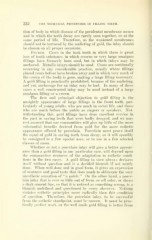Page 674 - My FlipBook
P. 674
332 THE TECHNICAL PEOCEDURES IN FHiLING TEETH.
tion of liody in which disease of the peridental membrane occurs
and in which the teeth decay are rarely seen together, or at the
same period of life. Therefore, as the weakened membranes
should not be tortured by the malleting of gold, the inlay should
be chosen on all proper occasions.
Fourth. Cases in the back teeth in which there is great
loss of tooth substance, in which crowns or very large amalgam
fillings have formerly been used, but in which inlays may be
anchored. Metallic inlays should be used. Cases are continually
occurring in any considerable practice, usually where fillings
placed years before have broken away and in which very much of
the crown of the tooth is gone, making a large filling necessary.
A gold filling is practically prohibited, because of the malleting,
and yet, anchorage for an inlay may be had. In many of these
cases a well constructed inlay may be used instead of a large
amalgam filling or a crown.
The first and principal objection to gold filling is the
i;nsightly appearance of large fillings in the front teeth, par-
ticularly of young adults, who are much in social life, and those
who are much before the public as singers or speakers. Not-
withstanding this, gold fillings have done excellent service in
the past in saving teeth that were badly decayed, and we may
rest assured that our communities will give up little of the more
substantial benefits derived from gold for the more esthetic
appearance offered by porcelain. Porcelain must prove itself
the equal of gold in saving teeth from decay, or it will speedily
be consigned to a few special uses, or to use in a few selected
classes of cases.
Whether or not a porcelain inlay will give a better appear-
ance than a gold filling in any particular case, will depend upon
the comparative neatness of the adaptation to esthetic condi-
tions in the two cases. A gold filling in view always declares
itself without question and is a decided blemish if not neatly
done. When well done and in good form, it gives an expression
of neatness and good taste that does much to obliterate the very
unesthetic sensation of "a patch." On the other hand, a porce-
lain inlay that is ever so little out of form, or off color, or shows
a dark cement line, so that it is noticed as something wrong, is a
blemish undefined and questioned by every observer. Nothing
violates esthetic ]irinci])les more radically than this condition
of question. Therefore, the porcelain inlay, to be successful
from Ihe esthetic standpoint, must be unseen. It must be prac-
tically jierfect work, or the well made gold filling is better from


